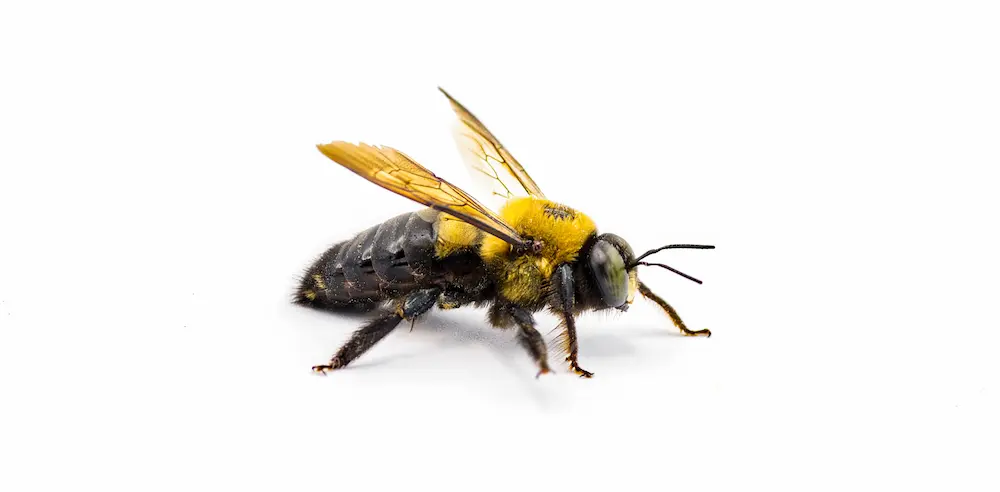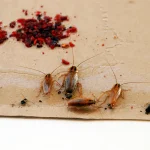
Illinois carpenters are known for carefully crafting beautiful and useful wood structures, but carpenter bees are known for ruining them with equal passion.
If your gorgeous new wood deck suddenly develops a mysterious, perfectly round hole, check the rest of your home’s wooden structures for holes and small piles of sawdust. If more signs are present, you may have a substantial carpenter bee infestation.
Read more in this guide to learn how to combat this destructive pest.
What do carpenter bees look like?
The carpenter bee is a relatively large black and yellow bee that may be mistaken for a bumble bee. You can differentiate the species by their appearance. Their abdomens are shiny and solid black instead of fuzzy.
Although they look intimidating, the male carpenter bee has no stinger, and the female is unlikely to sting unless provoked.

As their name suggests, these bees love to drill holes and tunnel into wood structures, which they use as nests.
The carpenter bee hibernates during the winter. But with the weather turning, stay on the lookout for male bees, who are out foraging while females start building their nests by deconstructing your property.
What does a carpenter bee sting look like?
If you are unlucky enough to be stung by a carpenter bee, the sting will likely be painful and cause localized swelling, redness, and itching. The severity of the reaction can vary from person to person, but it is usually not dangerous unless you have an allergy to bee stings.
If you are stung and experience symptoms such as difficulty breathing, hives, or dizziness, seek medical attention immediately.
What does a carpenter bee nest look like?
Carpenter bee nests are typically found inside soft, unpainted wood. The entrance hole is perfectly round and about ½ inch in diameter.
As the bee tunnels into the wood, it creates a series of chambers, each about an inch long, where it lays its eggs. You may see small piles of sawdust near the entrance hole, which is a telltale sign of carpenter bee activity.
What Kind of Damage Does the Carpenter Bee Cause?
The carpenter bee prefers to nest in soft, unpainted wood. Treated lumber is less likely to be affected. Pine, cypress, and cedar are popular targets.
Wood structures such as fascia boards, wood siding, porch ceilings, window trim, decks, and wooden swing sets are at risk.
A few holes are probably no reason to panic; the bee doesn’t quickly or systematically demolish structures like termites and carpenter ants do. However, cumulative damage over the years leads to larger numbers of tunnels, and this can cause several problems. Structural weakness is a possibility, and this can be enhanced if the bee tunnels become infiltrated by moisture, which will rot the wood.
Cosmetic problems caused by visible holes and stains from bee feces can be considerable. If you have a large number of nesting bees, the sounds that they make can entice woodpeckers to visit and add their own horrible carpentry skills to the mix.
5 Tips for Preventing Carpenter Bee Damage
- Choose hard or treated lumber for projects whenever possible.
- Finish lumber with several thick coats of varnish or paint.
- Cover wood structures with vinyl, masonry, or fiber cement.
- Place wooden items in shaded areas.
- Fill visible holes and cracks.
Are carpenter bees dangerous?
While carpenter bees are not typically aggressive, they can be a nuisance and cause significant damage to wooden structures over time. Male carpenter bees may hover around you, but they do not have a stinger and are harmless. Female carpenter bees can sting but rarely do so unless provoked or handled.
How can I tell if carpenter bees are in my home?
The most obvious sign of a carpenter bee infestation is the presence of round holes in wooden structures, along with small piles of sawdust. You may also hear a buzzing sound coming from within the wood, indicating that the bees are active inside their tunnels.
Are DIY solutions effective against carpenter bees?
While there are some DIY methods for deterring carpenter bees, such as painting or staining exposed wood, using insecticides, or plugging entrance holes, these solutions are often temporary and may not address the underlying infestation.
For a more comprehensive and long-lasting solution, it’s best to contact a professional stinging insect control company like Terminix Anderson.
Ready for a Pest Control Quote?
Click the button below to leave your information and we'll be in touch with a free quote!
More Frequently Asked Questions:
What should I do if I see a carpenter bee?
If you see a carpenter bee, do not swat at it or attempt to kill it, as this may provoke the bee to sting. Instead, contact Terminix Anderson for an inspection and treatment plan.
How do I know I have carpenter bees?
The presence of round holes in wood, sawdust piles, and buzzing sounds are all indicators of a carpenter bee infestation. If you notice any of these signs, it’s time to call Terminix Anderson for a professional assessment.
How does Terminix Anderson treat for carpenter bees?
At Terminix Anderson, we use a combination of techniques to effectively eliminate carpenter bee infestations. Our trained technicians will identify the affected areas, apply targeted treatments to eliminate the bees, and seal entrance holes to prevent future infestations. We also offer ongoing monitoring and prevention services to keep carpenter bees out.
What do I do if I see carpenter bees?
If you see carpenter bees on your property, contact Terminix Anderson right away. Our experienced team will assess the situation and develop a customized treatment plan to protect your home from these destructive pests.
Should I fill carpenter bee holes?
While filling carpenter bee holes may seem like a quick fix, it’s not a long-term solution. The bees will simply create new holes elsewhere. It’s best to leave the treatment of carpenter bee infestations to the professionals at Terminix Anderson.
How long can I wait to get rid of carpenter bees?
The longer you wait to address a carpenter bee infestation, the more damage they can cause to your wooden structures. It’s crucial to contact Terminix Anderson at the first sign of carpenter bee activity to minimize the extent of the damage and prevent the infestation from spreading.
We’ll Rid Your Home of Carpenter Bees
If carpenter bees become a serious problem, professional pest control is your best solution. At Terminix Anderson, we provide effective, environmentally friendly pest control to keep Illinois homeowners and businesses safe from wood-boring insects and other pests.
Contact us today to schedule an inspection or obtain more information.




